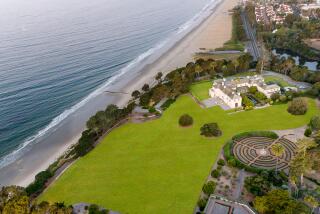Louisiana’s Great Plantation Homes
- Share via
If the house of your dreams has tall white columns that gleam like shafts of moonlight. . . .
If it is wrapped in the sweet, soft air of the South and framed by a lane of old oaks. . . .
If, in your heart, you think Scarlett was right and hoop skirts are fun and sugar is sweeter than saccharin, then pull out your checkbook. Your dream is for sale, 60 miles from New Orleans. The price is $4.8 million.
Built in 1839
The up-for-grabs plantation is Oak Alley, which was built in 1839 on the west bank of the Mississippi River by a French sugar planter named Jacques Telesphore Roman.
This Greek Revival home is three stories tall and etched with grace. A double row of gnarled oaks stretches for a quarter of a mile in front of the estate, and gives Oak Alley its name.
Louisiana plantation houses come onto the market every so often, a New Orleans realtor said. There’s a mystique about owning a Southern plantation, she added. Also, there’s a lot of hard work.
Some buyers are keen on historic preservation and want to keep such homes as museums. For others the major incentive is a tax benefit for rehabilitating a historic property. Sotheby’s International has the Oak Alley listing. Queries have come from prospective buyers in Asia and Europe.
Special Appeal
Oak Alley has picnic tables on its shady grounds as well as a pleasant restaurant. Behind the big house are six bed-and-breakfast cottages that have special appeal for foreign travelers, who take to a night in a Southern plantation the way Americans flock to English inns that spell olde with an e .
I saw Oak Alley when a New Orleans friend drove me on a daylong plantation tour up the winding River Road that follows the Mississippi levee out of New Orleans.
At Houmas House, a classic beauty near Burnside, it seemed that the family had just stepped out, perhaps to attend an afternoon wedding at a neighboring plantation. Perfume seemed to linger in the air.
You could hear the faint rustle of crinoline. I admired their music stands and marble mantels, their canopy beds and 22 antebellum armoires. I listened for their carriages to return.
Houmas House was built in 1840 and shows the gracious influence of both Spanish and French country style. It was spared during the Civil War because the owner claimed immunity as a British subject. Two floors are open to the public.
The gardens are as lavish as its furnishings. I had the eerie sense that I’d been there before; then I saw the spiral staircase and remembered that Houmas House was the setting for the Bette Davis film, “Hush Hush, Sweet Charlotte.”
Later I called at Madewood, a plantation near Napoleonville that offers lodging and candlelight dinner in the white-columned mansion, and other accommodations in a four-room, quilt-and-rustic cottage with fireplace. The guests that night were from Orleans, France.
Some of the planter temples along the bayous are privately owned and occupied. But each has a pull-off place so that travelers may glimpse the proud Southern architecture from before the Civil War.
Pillars and Posts
Not all plantations fit the classic image of white columns and wrap-around galleries. The Greek Revival notion swept the South with the power and wealth of the mid-1800s, a time when federal buildings, state capitols and courthouses around the land also were going to pillars and posts.
Earlier plantations in Louisiana copied the simpler style of West Indies homes, using high-pitched roofs that swooped 40 feet above the ground for ventilation. Broad galleries and enormous windows captured any breeze that might flit past in the almost tropical heat.
This is the style of Destrehan, an indigo and sugar cane plantation that haunts my memory. Destrehan is four rooms wide and three rooms deep. Each room leads to the next; there are no interior halls. Thick cypress beams, cut from trees in the swampy parts of the plantation, form the ceiling of the downstairs. They are the underside of the floorboards above.
Destrehan was begun in 1787 and completed in 1790. It is among the oldest buildings in the Mississippi Valley. The property remained in the Destrehan family until it was sold to Amoco Oil, but Amoco’s refinery closed in 1959 and the place deteriorated rapidly.
There was a legend that the pirate Jean Lafitte hid gold within the walls. Vandals and treasure hunters stripped the house of mantels, windows and paneling. They tore massive holes in the roof. They found no gold.
Bathtub Caper
One night a sheriff’s deputy saw lights near the house and turned on his siren. Thieves were hoisting a solid Carrara marble bathtub onto a flatbed truck. They dropped it in panic. It cracked, but did not break.
That tub, said to have been a gift to Jean-Noel Destrehan from Napoleon Bonaparte, is the only item that remains of the original furnishings. In 1972 Amoco donated the house and four acres to the River Road Historical Society, which launched an all-volunteer effort at restoration. Serenity again stalks the land.
There is no guest lodging at Destrehan, which is only eight miles from New Orleans International Airport. But you could buy Oak Alley and ride over for a neighborly visit.
More to Read
Sign up for The Wild
We’ll help you find the best places to hike, bike and run, as well as the perfect silent spots for meditation and yoga.
You may occasionally receive promotional content from the Los Angeles Times.






